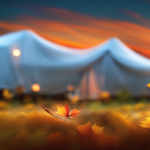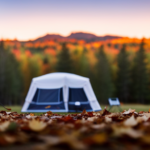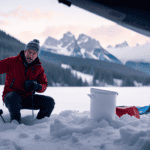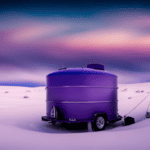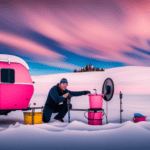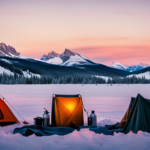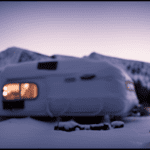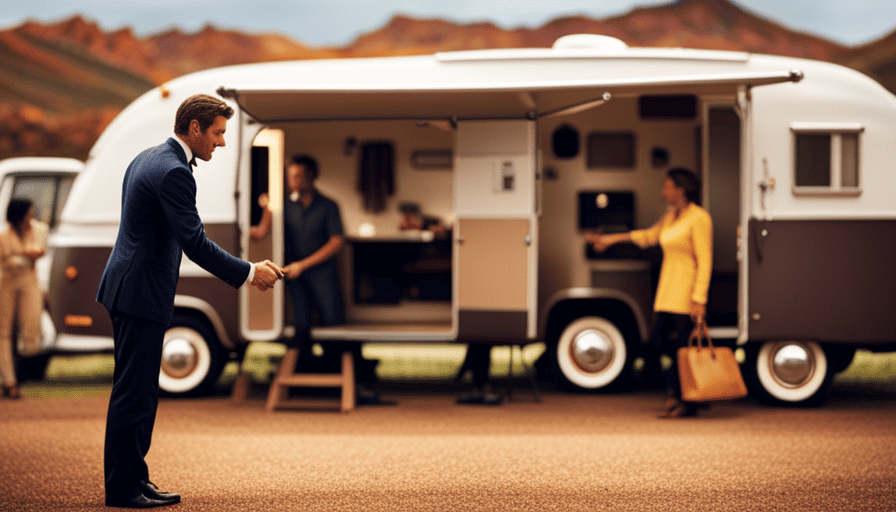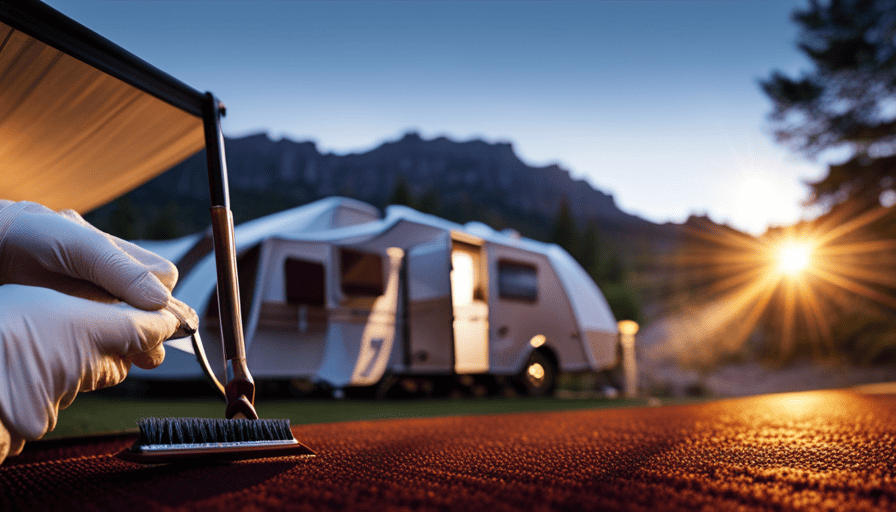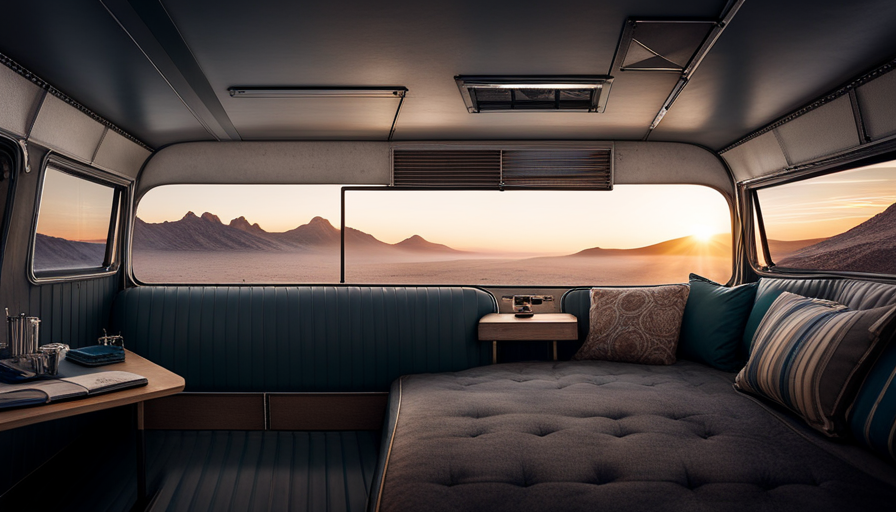Were you aware that in the United States, more than 9 million families have a camper? This indicates a vast number of campers that require appropriate winterization to safeguard them from the severe winter conditions. It’s crucial to winterize your camper to maintain its quality and to make sure it’s prepared for your upcoming camping trip.
But how long can a camper stay winterized? That’s a question many camper owners ponder as they prepare for the colder months. In this article, I will provide you with valuable insights and tips on how long you can safely keep your camper winterized, the effects of extended winterization, signs it’s time to de-winterize, and the steps to take when de-winterizing your camper.
So, let’s dive in and make sure your camper is well-prepared for the winter season.
Key Takeaways
- The duration of winterization depends on the location and severity of winter weather, including temperature fluctuations, snowfall, ice storms, and windstorms.
- Proper ventilation and temperature control are important for storage locations to prevent moisture buildup and mold growth.
- Extended winterization with proper insulation and maintenance is necessary to protect against freezing temperatures and prevent damage to plumbing and appliances.
- When de-winterizing a camper, steps include flushing water systems, inspecting seals and seams, charging batteries, and cleaning the fresh water tank.
Importance of Winterizing Your Camper
Winterizing your camper is crucial for ensuring its longevity and protecting it from potential damage during the cold winter months. By implementing proper preservation techniques, you can safeguard your investment and enjoy years of camping adventures.
One of the main benefits of winterization is that it prevents water from freezing and causing costly damage to your camper’s plumbing system. When water freezes, it expands and can burst pipes, leading to leaks and extensive repairs.
Winterizing also helps to protect the exterior of your camper from harsh weather conditions, such as snow, ice, and freezing temperatures. By covering your camper and sealing any potential entry points, you can prevent moisture from seeping in and causing mold, mildew, or rot.
Additionally, winterizing your camper reduces the risk of critters like mice and squirrels making their way inside and causing damage. It’s important to consider these factors when deciding how long to winterize your camper, as the duration of winterization will vary depending on your location and the severity of the winter weather.
Now, let’s explore the factors to consider when deciding how long to winterize.
Factors to Consider When Deciding How Long to Winterize
When deciding how long to winterize your camper, there are several factors to consider.
First, the climate and weather conditions in your area play a significant role. If you live in an area with harsh winters and freezing temperatures, it’s best to keep your camper winterized for the entire season.
Second, the storage location and conditions also matter. If your camper is stored in a heated garage or a climate-controlled facility, you may not need to winterize it for as long.
Lastly, the type of camper and materials used can impact how long you should winterize. Older or more delicate campers may require longer periods of winterization to prevent damage.
Climate and Weather Conditions
Bundle up, because you’ll be in for a wild ride when Mother Nature unleashes her wintry fury on your camper. Climate change has brought about more extreme weather events in recent years, making it crucial to consider the climate and weather conditions when deciding how long to winterize your camper.
Here are four factors to keep in mind:
-
Temperature fluctuations: From bone-chilling cold snaps to unseasonably warm days, the weather can be unpredictable. Your camper needs to be prepared for both.
-
Snowfall: Heavy snow can accumulate on your camper, potentially causing damage to the exterior and weighing it down.
-
Ice storms: Freezing rain can create hazardous conditions, coating your camper in ice and potentially causing power outages.
-
Windstorms: Strong gusts can not only make your camper colder but also cause damage to awnings, antennas, and other exterior components.
Considering these climate and weather factors, it’s important to find the right balance between keeping your camper winterized for protection and being able to enjoy it during milder winter periods.
Transitioning to the subsequent section about storage location and conditions, it’s essential to find a safe and suitable place to keep your camper during the winter months.
Storage Location and Conditions
Find a secure and suitable place to store your camper during the winter months to ensure its protection and longevity. When considering a storage location for your camper, it’s important to prioritize temperature control and proper ventilation.
Extreme temperature fluctuations can cause damage to the camper’s internal components and materials, such as freezing water lines or cracking seals. Look for a storage facility that offers climate-controlled units or select a location that allows you to maintain a consistent temperature inside the camper.
Additionally, proper ventilation is crucial to prevent the buildup of moisture and condensation, which can lead to mold and mildew growth. Adequate air circulation helps maintain the camper’s overall condition.
Now, let’s delve into the next section about the type of camper and materials used to further understand the winterization process.
Type of Camper and Materials Used
Choose your camper wisely, as its design and construction materials play a crucial role in determining the level of protection it provides during the winter months. Different camper types and the materials used in their construction can greatly affect their ability to withstand winter conditions. Here is a table that compares the winterization materials commonly used in different camper types:
| Camper Type | Winterization Materials |
|---|---|
| Popup | Insulated canvas |
| Travel | Fiberglass |
| Motorhome | Aluminum |
| Fifth Wheel | Fiberglass |
Popup campers, with their insulated canvas, may offer some protection but are generally less suitable for extended winterization. On the other hand, travel trailers and motorhomes, constructed with fiberglass or aluminum, provide better insulation and durability. It is important to consider the camper type and materials used when deciding how long to keep it winterized. Extended winterization can have effects on your camper, which we will discuss in the subsequent section about the effects of extended winterization on your camper.
Effects of Extended Winterization on Your Camper
When deciding how long to winterize my camper, I always consider the effects it can have on my camper. Extended winterization offers protection from freezing temperatures, preventing any potential damage to the plumbing and appliances. It also helps preserve the exterior and interior of the camper, ensuring that it remains in good condition for the next camping season.
Protection from Freezing Temperatures
To keep your camper protected from freezing temperatures, you’ll need to insulate the pipes and wrap them with heat tape. This is crucial in preventing frozen pipes, which can lead to costly repairs and damage to your camper.
When winterizing your camper, make sure to follow a comprehensive winterizing checklist that includes properly draining the water system, adding antifreeze to the pipes, and insulating any exposed areas. Insulating the pipes and using heat tape will provide an extra layer of protection against freezing temperatures.
It’s important to note that even with these measures in place, extended winterization can still have negative effects on your camper. In the next section, we’ll discuss how to prevent damage to plumbing and appliances during this time.
Preventing Damage to Plumbing and Appliances
One way to protect your plumbing and appliances is by properly insulating and maintaining them during the winter months. Preventing frozen pipes is essential to avoid costly repairs and potential water damage. To do this, make sure to insulate exposed pipes with pipe insulation or heat tape.
Additionally, you can open cabinet doors to allow warm air to circulate around pipes and keep a small trickle of water running through faucets to prevent freezing. Winterizing appliances is also crucial. Start by draining and bypassing the water heater, as well as disconnecting and draining any hoses connected to the washer and dishwasher. It’s also a good idea to clean and remove any debris from the refrigerator coils to ensure proper functioning.
By taking these steps, you can protect your plumbing and appliances from winter-related damage.
Now let’s move on to preserving the exterior and interior without writing ‘step’.
Preserving the Exterior and Interior
Keep in mind that properly maintaining the exterior and interior of your home is crucial to ensure its long-term durability and functionality. Here are four essential steps to preserve the exterior paint and maintain the interior furniture of your camper during winterization:
-
Apply a protective wax or sealant on the exterior paint to shield it from harsh winter elements like snow, ice, and road salt.
-
Clean and treat any leather or fabric furniture inside your camper with a specialized conditioner to prevent cracking or drying out.
-
Remove all food and perishable items from the interior to avoid attracting pests or causing unpleasant odors.
-
Use moisture-absorbing products, such as desiccant packs or dehumidifiers, to control humidity levels inside the camper and prevent mold or mildew growth.
By following these steps, you can extend the lifespan of your camper’s exterior paint and interior furniture.
Next, let’s discuss the signs that indicate it’s time to de-winterize your camper.
Signs It’s Time to De-Winterize Your Camper
Now that the warmer weather is on its way and the extended spring forecast looks promising, it’s time to start thinking about de-winterizing your camper.
With the increased chances of planned trips or camping opportunities coming up, it’s important to make sure your camper is ready to hit the road. Regular maintenance and check-ups are also crucial to ensure that everything is in working order and to avoid any unexpected issues while on your adventures.
Warmer Weather and Extended Spring Forecast
Enjoy the warmer weather and extended spring forecast as you wonder how long you can keep your camper winterized.
The arrival of spring brings with it the promise of an extended camping season and the benefits of camping in warmer weather. As the snow melts and the temperatures rise, it’s tempting to hit the road and embark on new adventures.
The smell of fresh air, the sound of birds chirping, and the sight of blooming flowers all add to the allure of camping during this time of year. Whether it’s exploring national parks, hiking scenic trails, lounging by the lake, or simply enjoying a peaceful evening under the stars, there are endless possibilities for outdoor enthusiasts.
So, as you plan your next trip or camping opportunity, consider all the wonders that await you in the great outdoors.
Planned Trips or Camping Opportunities
As you venture into the great outdoors, let the call of the wild guide you to extraordinary camping opportunities, like hidden gems waiting to be discovered.
With warmer weather on the horizon and an extended spring forecast, now’s the perfect time to plan your next camping trip. Whether you’re looking to explore national parks, hike through scenic trails, or simply relax by a peaceful lake, there are countless planned trips and camping opportunities to choose from.
From family-friendly campgrounds to remote wilderness sites, there’s something for everyone. But remember, before embarking on your adventure, it’s important to ensure your camper is properly maintained and checked-up. Regular maintenance, including inspecting the tires, brakes, and electrical systems, will help keep your camper in top shape for all your upcoming camping excursions.
Regular Maintenance and Check-ups
Make sure you don’t neglect regular maintenance and check-ups for your camper, so you can avoid any unexpected breakdowns and fully enjoy your camping adventure. Regular maintenance is crucial to keep your camper in top shape and ensure its longevity.
By scheduling regular check-ups, you can catch any potential issues before they become major problems, saving you time and money in the long run. Here are two key benefits of preventative maintenance:
-
Improved Safety: Regular check-ups allow professionals to inspect vital components such as brakes, tires, and electrical systems, ensuring they’re functioning properly and reducing the risk of accidents on the road.
-
Enhanced Performance: Routine maintenance helps optimize your camper’s performance, resulting in better fuel efficiency, smoother rides, and overall improved comfort during your trips.
By keeping up with regular maintenance and check-ups, you’ll be well-prepared to take the next steps to de-winterize your camper and hit the road with peace of mind.
Steps to De-Winterize Your Camper
First things first, you’ll need to gather all the necessary tools and supplies to de-winterize your camper. Before you begin, it’s essential to have a de-winterizing checklist to ensure you don’t miss any important steps.
This checklist should include items such as a water hose, RV antifreeze, a water pressure regulator, a battery charger, and cleaning supplies.
One of the most crucial steps in de-winterizing your camper is flushing the water systems. Over the winter months, water can stagnate and leave behind sediment and bacteria. Flushing the water lines, tanks, and faucets is essential to remove any leftover antifreeze or contaminants. This will help ensure the water in your camper is clean and safe to use.
To properly de-winterize and prepare your camper, there are a few tips to keep in mind. Firstly, make sure to inspect all the seals and seams for any signs of damage or wear. Replace any faulty seals to prevent water leaks. Secondly, charge the batteries and check their fluid levels. It’s also a good idea to clean and sanitize the fresh water tank to eliminate any bacteria that may have accumulated over the winter.
With these steps completed, you’ll be well on your way to enjoying your camper in the upcoming season without any winterization concerns.
Next, we’ll discuss some additional tips for getting your camper ready for your next adventure.
Tips for Properly De-Winterizing and Preparing Your Camper
Now that I’ve walked you through the steps to de-winterize your camper, it’s time to shift our focus to properly preparing it for the upcoming camping season. As an experienced camper, I understand the importance of taking the necessary steps to ensure your camper is in top shape for your adventures.
To get started, here are some tips for properly de-winterizing and preparing your camper:
-
Flush out the antifreeze: Make sure to thoroughly flush out any remaining antifreeze from your water system before using it. This will prevent any unpleasant taste or damage to your pipes.
-
Check the plumbing: Inspect all the plumbing connections and fixtures for any signs of leaks or damage. Replace any worn-out parts to avoid any issues during your camping trips.
-
Test the appliances: Turn on all your appliances, including the refrigerator, stove, and water heater, to make sure they’re in proper working condition. This will ensure that you can enjoy all the comforts of home while on the road.
-
Inspect the exterior: Take a close look at the exterior of your camper for any signs of damage or wear. Repair any cracks or holes, and give it a thorough cleaning to keep it looking its best.
-
Perform recommended maintenance: Follow the manufacturer’s recommendations for maintenance, such as checking the battery, tires, and brakes. This’ll help prevent any unexpected breakdowns during your journeys.
Now that your camper is properly de-winterized and prepared for the camping season, it’s time to move on to additional maintenance and precautions to ensure a smooth and enjoyable trip.
Additional Maintenance and Precautions for Camping Season
As an experienced camper, I understand the importance of regular cleaning and maintenance routines to ensure the longevity and functionality of my camper.
I also know that pest control and prevention measures are essential to keep unwanted critters away from my living space.
Additionally, I prioritize safety measures and emergency preparedness to ensure a worry-free camping experience.
Regular Cleaning and Maintenance Routine
To keep your camper in top shape during the winter months, you’ll want to make sure you stay on top of the regular cleaning and maintenance routine – it’s like giving your home away from home a warm, cozy hug that will make you even more excited for your next adventure. Regular maintenance is key to preventing any issues that may arise from neglecting your camper during the off-season. Establishing a cleaning schedule will help you stay organized and ensure that every area of your camper is properly cared for. Here is a helpful table to guide you through your regular cleaning and maintenance routine:
| Area | Frequency | Tasks |
|---|---|---|
| Exterior | Monthly | Wash, wax, inspect for damage |
| Interior | Bi-weekly | Dust, vacuum, sanitize surfaces |
| Appliances | Seasonally | Clean, test, and inspect |
| Plumbing System | Annually | Flush, check for leaks and clogs |
By following this routine, you’ll have a well-maintained camper ready for your next adventure. Now, let’s move on to the next section about pest control and prevention.
Pest Control and Prevention
Don’t let unwanted critters ruin your camping experience – keep pests at bay with effective pest control and prevention methods.
When it comes to pest control in your winterized camper, prevention is key. Start by thoroughly cleaning your camper and removing any food sources that may attract pests. Seal any cracks or openings in your camper to prevent rodents from entering. Consider using pest control methods such as traps or repellents to keep pests away.
Additionally, regularly inspect your camper for signs of infestation and take immediate action if you spot any. By taking these preventative measures, you can greatly reduce the risk of a rodent infestation in your winterized camper.
As we move on to the next section about safety measures and emergency preparedness, it’s important to stay vigilant and proactive in maintaining a pest-free camper.
Safety Measures and Emergency Preparedness
When it comes to winterizing your camper, pest control and prevention are crucial. However, it’s not the only thing you should consider. Safety measures and emergency preparedness should also be top priorities.
As someone who’s experienced my fair share of winter camping, I can tell you that being prepared for emergencies is essential. Make sure you have a well-stocked emergency supply kit that includes essentials like flashlights, extra batteries, a first aid kit, and non-perishable food. Additionally, it’s important to familiarize yourself with winter camping tips such as insulating your camper, using propane heaters safely, and checking for any potential hazards before settling in for the night.
By taking these precautions, you can ensure a safe and enjoyable winter camping experience.
Now, let’s move on to long-term winter storage considerations.
Long-Term Winter Storage Considerations
When it comes to long-term winter storage for your camper, there are a few key considerations to keep in mind. Firstly, it’s essential to store your camper in a covered area to protect it from the elements and prevent any damage.
Secondly, battery maintenance and charging are crucial to ensure that your camper’s battery remains in good condition throughout the winter months.
Lastly, securing and protecting your camper from potential theft or damage is important to give you peace of mind during the off-season.
By following these steps, you can ensure that your camper is well taken care of and ready for your next adventure.
Storing Your Camper in a Covered Area
To keep your camper in top condition during the winter months, you’ll want to find a covered area, like a cozy blanket for your camper, where it can be safely stored. Storing your camper in a covered area has many benefits. It provides protection from the elements such as snow, rain, and UV rays. It also helps prevent damage from falling branches or debris. Additionally, a covered area provides a barrier against pests like mice and insects that may try to take up residence in your camper during the winter. Another advantage of indoor storage is that it helps maintain the appearance of your camper, as it won’t be exposed to harsh weather conditions that can cause fading or peeling.
Now, let’s move on to the next section about battery maintenance and charging.
Battery Maintenance and Charging
Make sure you keep your camper’s battery in optimal condition by regularly maintaining and charging it. Battery maintenance is especially important during winter storage, as cold temperatures can cause a battery to lose its charge more quickly. To help you understand the importance of battery maintenance, here is a helpful table:
| Battery Maintenance Tips | Description |
|---|---|
| Clean the battery terminals | Remove any corrosion or buildup on the terminals with a wire brush. |
| Check the fluid levels | Ensure that the battery’s water levels are topped up, if applicable. |
| Charge the battery | Use a battery charger to keep the battery charged during storage. |
| Disconnect the battery | Disconnecting the battery can prevent any parasitic drain during storage. |
| Store the battery properly | Keep the battery in a cool, dry place away from flammable materials. |
By following these battery maintenance tips, you can ensure that your camper’s battery remains in good condition throughout the winter. Now, let’s move on to securing and protecting your camper.
Securing and Protecting Your Camper
Safeguard your sanctuary on wheels by securing and shielding your cherished chariot from potential perils. As the winter season approaches, it’s crucial to take the necessary steps to protect your camper from damage.
Here are some securing methods and winter protection measures to consider:
-
Lock it up tight: Invest in high-quality locks for all entry points, including doors, windows, and storage compartments.
-
Cover it up: Use a durable, weather-resistant cover to shield your camper from harsh winter elements like snow, ice, and wind.
-
Seal the gaps: Inspect and seal any gaps or cracks in the exterior to prevent water leaks and drafts.
-
Elevate it: Park your camper on blocks or jack stands to avoid direct contact with the ground and potential moisture damage.
By implementing these securing methods and winter protection measures, you can ensure the longevity of your camper throughout the cold months.
Now, let’s delve into some common mistakes to avoid during winterization and de-winterization.
Common Mistakes to Avoid During Winterization and De-Winterization
When it comes to winterizing and de-winterizing a camper, there are a few common mistakes that should be avoided. One of the most important things to remember is to ensure adequate drainage of the water systems. Failing to do so can lead to frozen and damaged pipes.
Additionally, it’s crucial to remember to remove all perishable items from the camper before winterizing, as they can spoil and attract pests.
Lastly, it’s essential to check for rodents or pests that may have made their way into the camper during the winter months. Taking these precautions will help ensure a smooth transition from winter storage to camping season.
Inadequate Drainage of Water Systems
You’ll regret not properly draining your water systems, as it could lead to costly repairs and extensive damage to your camper during the winter months. Inadequate drainage of water systems is a common mistake that can result in frozen pipes and a whole host of problems. Here are a few reasons why you should make sure your camper’s water systems are thoroughly drained:
- Frozen pipes can burst, causing leaks and water damage.
- Standing water can freeze and expand, damaging tanks and fittings.
- Mold and mildew can thrive in damp areas, leading to health issues and unpleasant odors.
- Inadequate drainage can also lead to corrosion and rust, further deteriorating your camper’s water systems.
Remember, proper winterization involves more than just turning off the water supply. So, don’t forget to remove perishable items before moving on to the next section.
Forgetting to Remove Perishable Items
Don’t forget to clear out any perishable items before moving on to the next step, or else you may find a nasty surprise waiting for you when you return. Preventing spoilage is crucial when winterizing your camper.
It’s important to remove all food items that can spoil or attract pests. Start by thoroughly cleaning out your refrigerator and pantry, discarding any expired or opened items. Consider donating any non-perishable items that you won’t be using during the winter months.
When it comes to food storage options, there are a few choices to consider. You can bring your perishables home with you, store them in airtight containers, or utilize a cooler with ice packs. Remember, proper food storage will help prevent unpleasant odors and the growth of mold or bacteria.
Now, let’s move on to the next section about neglecting to check for rodents or pests.
Neglecting to Check for Rodents or Pests
Neglecting to check for rodents or pests can lead to costly damages and an unpleasant surprise upon your return. It’s essential to take preventive measures to keep these unwanted guests out of your winterized camper. Rodents, such as mice and rats, are notorious for seeking shelter in vehicles during the colder months, and they can cause significant damage by chewing through wires, insulation, and upholstery. To avoid this, make sure to seal any potential entry points, such as gaps around pipes or vents. Additionally, consider placing rodent repellents or traps inside the camper as an extra precaution. When it comes to winter pest control, it’s better to be safe than sorry. By taking the time to inspect and secure your camper, you can minimize the risk of costly repairs and ensure a hassle-free return to camping season. Now, let’s move on to the conclusion and final thoughts on winterizing and de-winterizing your camper.
Conclusion and Final Thoughts on Winterizing and De-Winterizing Your Camper
In a nutshell, winterizing your camper is like putting it into a deep, peaceful hibernation until the warm embrace of spring wakes it up again. As someone who’s been camping for years, I can confidently say that planning ahead and considering the cost of winterization are crucial factors to keep in mind.
When it comes to planning ahead, it’s important to think about the specific needs of your camper. Different campers have different requirements for winterization, so it’s essential to educate yourself on the specific steps needed to protect your investment. This may involve draining water lines, adding antifreeze, and sealing vents to prevent moisture buildup.
In terms of cost, winterization can vary depending on whether you choose to do it yourself or hire a professional. While doing it yourself may save money, it’s important to ensure you have the necessary knowledge and tools to do the job correctly. Hiring a professional may be more expensive, but it guarantees that the winterization process is done properly.
Ultimately, taking the time and effort to properly winterize your camper will help prevent costly damage from occurring during the winter months. By planning ahead and considering the cost of winterization, you can ensure that your camper stays protected and ready for your next adventure when spring arrives.
Frequently Asked Questions
How does winterization affect the lifespan of my camper?
Winterization greatly affects the lifespan of your camper. By protecting it from the harsh winter elements, you can ensure its performance remains top-notch.
When properly winterized, your camper is shielded from freezing temperatures, which can cause damage to plumbing, appliances, and the overall structure. This preventive measure also prevents costly repairs and extends the life of your camper.
The benefits of winterization include peace of mind, saving money in the long run, and preserving the value of your investment.
Can I still use my camper for short trips while it is winterized?
Yes, you can still use your camper for short trips even if it’s winterized. Winterizing your camper is actually advantageous for long-term storage as it protects the plumbing system from freezing temperatures. However, when using a winterized camper for short trips, you’ll need to bring your own water supply and use portable toilets as the plumbing system won’t be functional. Overall, with the right preparations, you can still enjoy your camper during the winter months.
Are there any risks associated with leaving a camper winterized for an extended period of time?
Leaving a camper winterized for an extended period can pose risks of freezing and have a detrimental impact on the plumbing system. Freezing temperatures can cause damage to water lines, fittings, and tanks, resulting in costly repairs.
Additionally, prolonged winterization can lead to the buildup of moisture and mold inside the camper. To ensure the longevity of your camper, it’s best to properly de-winterize and use it regularly during the offseason.
What steps should I take to ensure my camper is properly de-winterized before using it again?
To properly de-winterize your camper, start by removing any covers and inspecting the exterior for any signs of damage.
Next, flush the water system by reconnecting the water supply and running water through all faucets.
Check the battery and electrical systems for any issues and charge or replace as needed.
Don’t forget to check the tires and brakes for proper functioning.
Common mistakes to avoid include forgetting to empty and clean the holding tanks and not properly resealing any openings or seams.
Are there any specific maintenance tasks that should be done after de-winterizing my camper to prepare it for camping season?
After de-winterizing my camper, there are several important maintenance tasks I always make sure to do before hitting the road for camping season.
First, I thoroughly inspect all the exterior and interior components for any signs of damage or wear.
Next, I check and clean the plumbing system, as winterization effects can sometimes cause issues.
Additionally, I test all the electrical systems and appliances to ensure they’re in proper working order.
Finally, I give the camper a good cleaning, inside and out, to freshen it up for the season ahead.
How Long Should I Wait Before Plugging In My Camper Fridge After Winterizing?
The camper fridge cooling time after winterizing varies depending on the specific model and method of winterization used. It is generally recommended to wait at least 24 hours before plugging in the fridge to allow it to reach the ideal temperature and prevent potential damage.
Conclusion
In conclusion, winterizing and de-winterizing your camper is a crucial step in maintaining its longevity and performance. By taking the time to properly prepare your camper for the winter months, you can avoid costly repairs and ensure a smooth camping season ahead.
Remember, it’s important to consider factors such as climate, storage conditions, and personal preferences when deciding how long to winterize. So whether you choose to keep your camper winterized for a few months or the entire season, following the proper steps and precautions will ensure that your camper is ready to hit the road when the time comes.
Happy camping!



